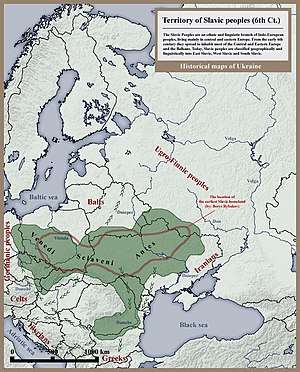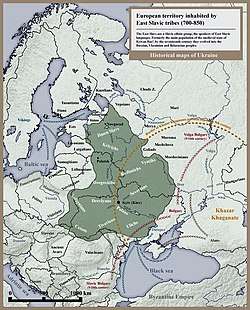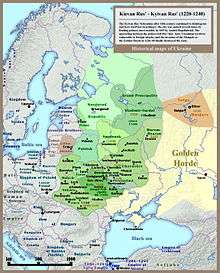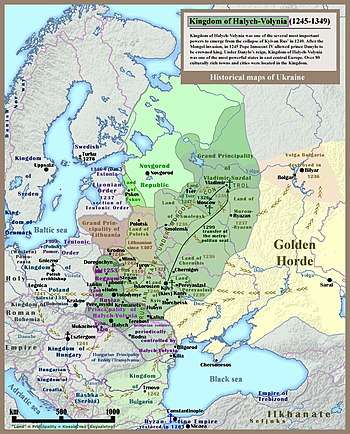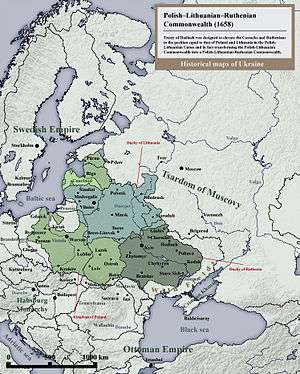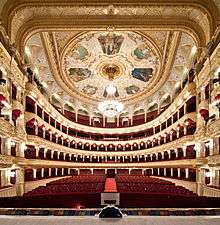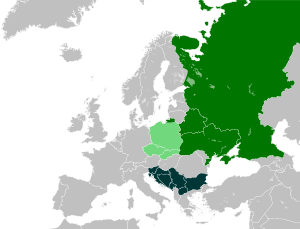Ukrainians
Ukrainians (Ukrainian: українці, romanized: ukrayintsi, pronounced [ʊkrɐˈjinʲts⁽ʲ⁾i]), historically also called Ruthenians, are an East Slavic ethnic group native to Ukraine, which is by total population the seventh-largest[48] nation in Europe and the second-largest among the East Slavs after the Russians. The Constitution of Ukraine applies the term 'Ukrainians' to all its citizens.[49] The people of Ukraine have historically been known as "Rusyns (Carpatho-Ruthenians)", "Little Russians", and "Cossacks", among others. The connection with the Zaporozhian Cossacks especially, is emphasized in the Ukrainian national anthem, "We are, brothers, of Cossack kin". According to most dictionary definitions, a descriptive name for the "inhabitants of Ukraine" is Ukrainian or Ukrainian people.[50] The majority of Ukrainians are Eastern Orthodox Christians.
| Total population | |
|---|---|
c. 37 – c. 45 million[1][2]
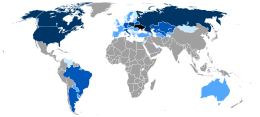 | |
| Regions with significant populations | |
| 3,269,992 (2015)[4] | |
| 1,359,655 (2016)[5] | |
| 1,200,000 (2017)[4] | |
| 1,028,492 (2016)[6] | |
| 600,000 (2015)[7] | |
| 338,022 (2015)[8] | |
| 325,235 (2014)[9][10] | |
| 305,000 (2007)[11][12] | |
| 272,000 (2016)[13] | |
| 234,354 (2017)[14] | |
| 225,734 (2015)[4] | |
| 131,709 (2018)[15] | |
| 124,602 (2015)[16] | |
| 90,530–100,000 (2016)[17][18] | |
| 51,703–200,000 (2011)[19][20] | |
| 50,699 (2018)[21] | |
| 45,051 (2015)[16] | |
| 40,000 (2016)[22] | |
| 38,791 (2014)[23][24] | |
| 32,000 (2016)[25] | |
| 30,000–90,000 (2016)[26] | |
| 23,414 (2015)[8] | |
| 23,183 (2017)[27] | |
| 22,263 (2015)[4] | |
| 21,509 (2009)[28] | |
| 20,000–35,000 (2016)[29][30] | |
| 12,691 (2016)[31] | |
| 12,248 (2015)[4] | |
| 12,144 (2018)[32] | |
| 12,000–40,000 (2014)[33][34] | |
| 12,000 (2016)[35] | |
| 11,145 (2017)[36] | |
| 11,069 (2019)[37] | |
| 10,996 (2016)[38] | |
| 10,001 (2015)[8] | |
| 10,000–15,000 (1990)[39][40] | |
| 6,681 (2017)[41] | |
| 5,000 (2016)[42] | |
| 5,000 (2016)[43] | |
| 5,000 (2016)[44] | |
| Languages | |
| Ukrainian, Russian[45][46] | |
| Religion | |
| |
| Related ethnic groups | |
| Other East Slavs | |
Ethnonym
The ethnonym Ukrainians came into wide use only in the 20th century after the territory of Ukraine obtained distinctive statehood in 1917.[51] From the 14th to the 16th centuries the Western portions of the European part of what is now known as Russia, plus the territories of northern Ukraine and Belarus (Western Rus') were largely known as Rus', continuing the tradition of Kievan Rus'. People of these territories were usually called Rus or Rusyns (known as Ruthenians in Western and Central Europe).[52][53] The Ukrainian language appeared in the 14th to 16th centuries (with some prototypical features already evident in the 11th century), but at that time, it was mostly known as Ruthenian, like its sister-languages. In the 16th to 17th centuries, with the establishment of the Zaporizhian Sich, the notion of Ukraine as a separate country with a separate ethnic identity came into being.[54] However, the ethnonym Ukrainians and the linguonym Ukrainian were used only occasionally, and the people of Ukraine usually continued to call themselves and their language Ruthenian. After the decline of the Zaporizhian Sich and the establishment of Imperial Russian hegemony in Ukraine (17th to 18th centuries), Ukrainians became more widely known by the Russian regional name, Little Russians (Malorossy), with the majority of Ukrainian élites espousing Little Russian identity.[55][56][57] This official name (usually regarded now as colonial and humiliating) did not spread widely among the peasantry which constituted the majority of the population.[58] Ukrainian peasants still referred to their country as "Ukraine" (a name associated with the Zaporizhian Sich, with the Hetmanate and with their struggle against Poles, Russians, Turks and Crimean Tatars) and to themselves and their language as Ruthenians/Ruthenian.[56][57] With the publication of Ivan Kotliarevsky's Eneyida (Aeneid) in 1798, which established the modern Ukrainian language, and with the subsequent Romantic revival of national traditions and culture, the ethnonym Ukrainians and the notion of a Ukrainian language came into more prominence at the beginning of the 19th century and gradually replaced the words "Rusyns" and "Ruthenian(s)". In areas outside the control of the Russian/Soviet state until the mid-20th century (Western Ukraine), Ukrainians were known by their pre-existing names for much longer.[55][56][57][59] The appellation Ukrainians initially came into common usage in Central Ukraine[60][61] and did not take hold in Galicia and Bukovyna until the latter part of the 19th century, in Transcarpathia until the 1930s, and in the Prešov Region until the late 1940s.[62][63][64]
The modern name ukrayintsi (Ukrainians) derives from Ukrayina (Ukraine), a name first documented in 1187.[65] Several scientific theories attempt to explain the etymology of the term.
According to the traditional theory (especially predominant in Russia), it derives from the Proto-Slavic root *kraj-, which has two meanings, one meaning the homeland as in "nash rodnoi kraj" (our homeland), and the other "edge, border", and originally had the sense of "periphery", "borderland" or "frontier region" etc.[66][67][68]
According to some new alternative Ukrainian historians such as Hryhoriy Pivtorak, Vitaly Sklyarenko and other scholars, translate the term "u-kraine" as "in-land", "home-land" or "our-country".[66] The name in this context derives from the word "u-kraina" in the sense of "domestic region", "domestic land" or "country" (inside the country).[69][70][71]
In the last three centuries the population of Ukraine experienced periods of Polonization and Russification, but preserved a common culture and a sense of common identity.[72][73]
Geographic distribution


| Part of a series on |
| Ukrainians |
|---|
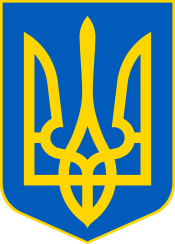 |
| Diaspora |
|
see Template:Ukrainian diaspora |
| Sub-national groups |
| Boikos · Hutsuls · Lemkos · Poleszuks |
| Closely-related peoples |
|
East Slavs (parent group) Rusyns · Poleszuks · Kuban Cossacks Pannonian Rusyns |
| Culture |
|
Architecture · Art · Cinema · Cuisine Dance · Language · Literature · Music Sport · Theater |
| Religion |
|
Eastern Orthodox (Moscow Patriarchate Orthodox Church of Ukraine) Greek Catholicism Roman Catholicism Judaism (among ethnic Jews) |
| Languages and dialects |
|
Ukrainian Russian · Canadian Ukrainian · Rusyn · Pannonian Rusyn Balachka · Surzhyk · Lemko |
|
History · Rulers List of Ukrainians |
Most ethnic Ukrainians live in Ukraine, where they make up over three-quarters of the population. The largest population of Ukrainians outside of Ukraine lives in Russia where about 1.9 million Russian citizens identify as Ukrainian, while millions of others (primarily in southern Russia and Siberia) have some Ukrainian ancestry.[74] The inhabitants of the Kuban, for example, have vacillated among three identities: Ukrainian, Russian (an identity supported by the Soviet regime), and "Cossack".[49] Approximately 800,000 people of Ukrainian ancestry live in the Russian Far East in an area known historically as "Green Ukraine".[75]
In a 2011 national poll of Ukraine, 49% of Ukrainians said they had relatives living in Russia.[76]
According to some previous assumptions, an estimated number of almost 2.4 million people of Ukrainian origin live in North America (1,359,655 in Canada and 1,028,492 in the United States). Large numbers of Ukrainians live in Brazil (600,000),[nb 1] Kazakhstan (338,022), Moldova (325,235), Argentina (305,000), (Germany) (272,000), Italy (234,354), Belarus (225,734), Uzbekistan (124,602), the Czech Republic (110,245), Spain (90,530–100,000) and Romania (51,703–200,000). There are also large Ukrainian communities in such countries as Latvia, Portugal, France, Australia, Paraguay, the UK, Israel, Slovakia, Kyrgyzstan, Austria, Uruguay and the former Yugoslavia. Generally, the Ukrainian diaspora is present in more than one hundred and twenty countries of the world.
The number of Ukrainians in Poland amounted to some 51,000 people in 2011 (according to the Polish Census).[77] Since 2014, the country has experienced a large increase in immigration from Ukraine.[78][79] More recent data put the number of Ukrainian workers at 1.2[80] – 1.3 million in 2016.[81][nb 2]
In the last decades of the 19th century, many Ukrainians were forced by the Tsarist autocracy to move to the Asian regions of Russia, while many of their counterpart Slavs under Austro-Hungarian rule emigrated to the New World seeking work and better economic opportunities.[82] Today, large ethnic Ukrainian minorities reside in Russia, Canada, the United States, Brazil, Kazakhstan, Italy and Argentina.[83] According to some sources, around 20 million people outside Ukraine identify as having Ukrainian ethnicity,[84][85][86] however the official data of the respective countries calculated together doesn't show more than 10 million. Ukrainians have one of the largest diasporas in the world.
Origin
The East Slavs emerged from the undifferentiated early Slavs in the Slavic migrations of the 6th and 7th centuries CE. The state of Kievan Rus' united the East Slavs during the 9th to 13th centuries. East Slavic tribes cited as "proto-Ukrainian" include the Volhynians, Derevlianians, Polianians, and Siverianians and the less significant Ulychians, Tivertsians, and White Croats.[87] The Gothic historian Jordanes and 6th-century Byzantine authors named two groups that lived in the south-east of Europe: Sclavins (western Slavs) and Antes. Polianians are identified as the founders of the city of Kiev and as playing the key role in the formation of the Kievan Rus' state.[88] At the beginning of the 9th century, Varangians used the waterways of Eastern Europe for military raids and trade, particularly the trade route from the Varangians to the Greeks. Until the 11th century these Varangians also served as key mercenary troops for a number of princes in medieval Kiev, as well as for some of the Byzantine emperors, while others occupied key administrative positions in Kievan Rus' society, and eventually became slavicized.[89][90] Besides other cultural traces, several Ukrainian names show traces of Norse origins as a result of influences from that period.[91][92]
Differentiation between separate East Slavic groups began to emerge in the later medieval period, and an East Slavic dialect continuum developed within the Polish–Lithuanian Commonwealth, with the Ruthenian language emerging as a written standard. The active development of a concept of a Ukrainian nation and a Ukrainian language began with the Ukrainian National Revival in the early 19th century. In the Soviet era (1917–1991), official historiography emphasized "the cultural unity of 'proto-Ukrainians' and 'proto-Russians' in the fifth and sixth centuries".[93]
Genetics
The Ukrainian gene-pool includes the following Y-haplogroups, in order from the most prevalent:[94]
Roughly all R1a Ukrainians carry R1a-Z282; R1a-Z282 has been found significantly only in Eastern Europe.[95] Chernivtsi Oblast is the only region in Ukraine where Haplogroup I2a occurs more frequently than R1a, much less frequent even in Ivano-Frankivsk Oblast.[96] In comparison to their northern and eastern neighbors, Ukrainians have a similar percentage of Haplogroup R1a-Z280 (43%) in their population—compare Belarusians, Russians, and Lithuanians and (55%, 46%, and 42% respectively). Populations in Eastern Europe which have never been Slavic do as well. Ukrainians in Chernivtsi Oblast (near the Romanian border) have a higher percentage of I2a as opposed to R1a, which is typical of the Balkan region, but a smaller percentage than Russians of the N1c1 lineage found among Finnic, Baltic, and Siberian populations, and also less R1b than West Slavs.[97][98][99] In terms of haplogroup distribution, the genetic pattern of Ukrainians most closely resembles that of Belarusians. The presence of the N1c lineage is explained by a contribution of the assimilated Finno-Ugric tribes.[100]
Sub-ethnic groups
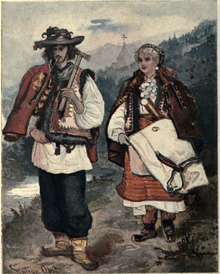
Among Ukrainians, there are several distinct subethnic groups, especially in western Ukraine: places like Zakarpattia and Halychyna. Among them the most known are Hutsuls,[101] Volhynians, Boykos and Lemkos (otherwise known as Rusyns – a derivative of Ruthenians),[102] each with peculiar area of settlement, dialect, dress, anthropological type and folk traditions. There are several theories about the origin of each of these groups. Some of these subethnic groups were strongly influenced by the neighboring nations, but according to all relevant indicators they belong to the mainstream of Ukrainian people.
History
Early history

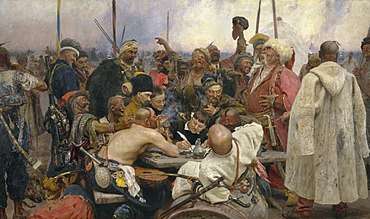
Ukraine has had a very turbulent history, a fact explained by its geographical position. In the 9th century the Varangians from Scandinavia conquered the proto-Slavic tribes on the territory of today's Ukraine, Belarus, and western Russia and laid the groundwork for the Kievan Rus’ state. The ancestors of the Ukrainian nation such as Polianians had an important role in the development and culturalization of Kievan Rus’ state. The internecine wars between Rus' princes, which began after the death of Yaroslav the Wise,[103] led to the political fragmentation of the state into a number of principalities. The quarreling between the princes left Kievan Rus’ vulnerable to foreign attacks, and the invasion of the Mongols in 1236. and 1240. finally destroyed the state. Another important state in the history of the Ukrainians is Kingdom of Galicia–Volhynia (1199–1349).[104][105]
The third important state for Ukrainians is Cossack Hetmanate. The Cossacks of Zaporizhia since the late 15th century controlled the lower bends of the river Dnieper, between Russia, Poland and the Tatars of Crimea, with the fortified capital, Zaporizhian Sich. Hetman Bohdan Khmelnytsky is one of the most celebrated and at the same time most controversial political figures in Ukraine's early-modern history. A brilliant military leader, his greatest achievement in the process of national revolution was the formation of the Cossack Hetmanate state of the Zaporozhian Host (1648–1782). The period of the Ruin in the late 17th century in the history of Ukraine is characterized by the disintegration of Ukrainian statehood and general decline. During the Ruin Ukraine became divided along the Dnieper River into Left-Bank Ukraine and Right-Bank Ukraine, and the two-halves became hostile to each other. Ukrainian leaders during the period are considered to have been largely opportunists and men of little vision who could not muster broad popular support for their policies.[106] There were roughly 4 million Ukrainians at the end of the 17th century.[107]
At the final stages of the First World War, a powerful struggle for an independent Ukrainian state developed in the central Ukrainian territories, which, until 1917, were part of the Russian Empire. The newly established Ukrainian government, the Central Rada, headed by Mykhailo Hrushevsky, issued four universals, the Fourth of which, dated 22 January 1918, declared the independence and sovereignty of the Ukrainian National Republic (UNR) on 25 January 1918. The session of the Central Rada on 29 April 1918 ratified the Constitution of the UNR and elected Hrushevsky president.[72]
Soviet period
During 1932–1933, millions of Ukrainians were starved to death by a Soviet regime which led to a famine, known as the Holodomor.[108] The Soviet regime remained silent about the Holodomor and provided no aid to the victims or the survivors. But news and information about what was going on reached the West and evoked public responses in Polish-ruled Western Ukraine and in the Ukrainian diaspora. Since the 1990s the independent Ukrainian state, particularly under President Viktor Yushchenko, the Ukrainian mass media and academic institutions, many foreign governments, most Ukrainian scholars, and many foreign scholars have viewed and written about the Holodomor as genocide and issued official declarations and publications to that effect. Modern scholarly estimates of the direct loss of human life due to the famine range between 2.6 million[109][110] (3–3.5 million)[111] and 12 million[112] although much higher numbers are usually published in the media and cited in political debates.[113] As of March 2008, the parliament of Ukraine and the governments of several countries, including the United States have recognized the Holodomor as an act of genocide.[nb 3]
Historical maps of Ukraine
The Ukrainian state has occupied a number of territories since its initial foundation. Most of these territories have been located within Eastern Europe, however, as depicted in the maps in the gallery below, has also at times extended well into Eurasia and South-Eastern Europe. At times there has also been a distinct lack of a Ukrainian state, as its territories were on a number of occasions, annexed by its more powerful neighbours.
| Historical maps of Ukraine and its predecessors |
|---|
|
Ethnic/national identity


The watershed period in the development of modern Ukrainian national consciousness was the struggle for independence during the creation of the Ukrainian People's Republic from 1917 to 1921.[114] A concerted effort to reverse the growth of Ukrainian national consciousness was begun by the regime of Joseph Stalin in the late 1920s, and continued with minor interruptions until the most recent times. The man-made Famine-Genocide of 1932–33, the deportations of the so-called kulaks, the physical annihilation of the nationally conscious intelligentsia, and terror in general were used to destroy and subdue the Ukrainian nation.[115] Even after Joseph Stalin's death the concept of a Russified though multiethnic Soviet people was officially promoted, according to which the non-Russian nations were relegated to second-class status. Despite this, many Ukrainians played prominent roles in the Soviet Union, including such public figures as Semyon Timoshenko.
The creation of a sovereign and independent Ukraine in 1991, however, pointed to the failure of the policy of the "merging of nations" and to the enduring strength of the Ukrainian national consciousness. Today, one of the consequences of these acts is Ukrainophobia.[116]
Biculturalism is especially present in southeastern Ukraine where there is a significant Russian minority. Historical colonization of Ukraine is one reason that creates confusion about national identity to this day.[117] Many citizens of Ukraine have adopted the Ukrainian national identity in the past 20 years. According to the concept of nationality dominant in Eastern Europe the Ukrainians are people whose native language is Ukrainian (an objective criterion) whether or not they are nationally conscious, and all those who identify themselves as Ukrainian (a subjective criterion) whether or not they speak Ukrainian.[118]
Attempts to introduce a territorial-political concept of Ukrainian nationality on the Western European model (presented by political philosopher Viacheslav Lypynsky) were unsuccessful until the 1990s. Territorial loyalty has also been manifested by the historical national minorities living in Ukraine. The official declaration of Ukrainian sovereignty of 16 July 1990 stated that "citizens of the Republic of all nationalities constitute the people of Ukraine."[119][120]
Culture

Due to Ukraine's geographical location, its culture primarily exhibits Eastern European influence as well as Central European to an extent (primarily in the western region). Over the years it has been influenced by movements such as those brought about during the Byzantine Empire and the Renaissance. Today, the country is somewhat culturally divided with the western regions bearing a stronger Central European influence and the eastern regions showing a significant Russian influence. A strong Christian culture was predominant for many centuries, although Ukraine was also the center of conflict between the Catholic, Orthodox and Islamic spheres of influence.
Languages
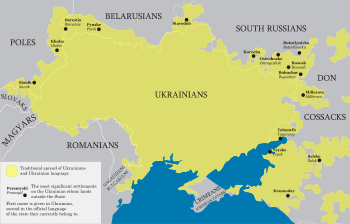

Ukrainian (украї́нська мо́ва, ukrayíns'ka móva) is a language of the East Slavic subgroup of the Slavic languages. It is the only official state language of Ukraine. Written Ukrainian uses the Ukrainian alphabet, one of many based on the Cyrillic alphabet.
The Ukrainian language traces its origins to the Old East Slavic language of the medieval state of Kievan Rus'. In its earlier stages it was called Ruthenian in Latin. Ukrainian, along with all other East Slavic languages, is a lineal descendant of the colloquial language used in Kievan Rus' (10th–13th century).[121]
While the Golden Horde placed officials in key Kievan Rus areas, practised forced resettlement, and even renamed urban centers to suit their own language, the Mongols did not attempt to annihilate Kievan Rus society and culture. The second onslaught began with the destruction of Kiev by the Golden Horde in 1240. This khanate formed the western part of a great Mongol Empire that had been founded by Genghis Khan in the early 13th century. After the Mongol destruction of Kievan Rus in the 13th century, literary activity in Ukraine declined. A revival began in the late 18th century in eastern Ukraine with overlapping literary and academic phases at a time when nostalgia for the Cossack past and resentment at the loss of autonomy still lingered on.
The language has persisted despite several periods of bans and/or discouragement throughout centuries as it has always nevertheless maintained a sufficient base among the people of Ukraine, its folklore songs, itinerant musicians, and prominent authors.
According to the 2001 Ukrainian census, 67.5% of Ukrainians (citizens of Ukraine) and 85.2% of ethnic Ukrainians named Ukrainian as their mother-tongue, and 14.8% named Russian as their mother-tongue.[122] This census does not cover Ukrainians living in other countries.[123]
Religions
Ukraine was inhabited by pagan tribes until Byzantine rite Christianity was introduced by the turn of the first millennium. It was imagined by later writers who sought to put Kievan Christianity on the same level of primacy as Byzantine Christianity that Apostle Andrew himself had visited the site where the city of Kiev would be later built.
However it was only by the 10th century that the emerging state, the Kievan Rus', became influenced by the Byzantine Empire; the first known conversion was by the Princess Saint Olga who came to Constantinople in 945 or 957. Several years later, her grandson, Knyaz Vladimir baptised his people in the Dnieper River. This began a long history of the dominance of the Eastern Orthodoxy in Ruthenia (Ukraine).
Ukrainians are predominantly Orthodox Christians. In the eastern and southern areas of Ukraine the Ukrainian Orthodox Church under the jurisdiction of the Moscow Patriarchate is the most common. In central and western Ukraine there is support for the Ukrainian Orthodox Church – Kiev Patriarchate headed by Patriarch Filaret and also in the western areas of Ukraine and with smaller support throughout the country there is support for the Ukrainian Autocephalous Orthodox Church headed by Metropolitan Mefodiy.
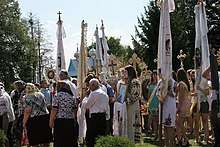
In the Western region known as Galicia the Ukrainian Greek Catholic Church, one of the Eastern Rite Catholic Churches has a strong membership. Since the fall of the Soviet Union there has been a growth of Protestant churches[nb 4] and Rodnovery, a contemporary Slavic modern pagan religion.[124] There are also ethnic minorities that practice other religions, i.e. Crimean Tatars (Islam), and Jews and Karaim (Judaism).
A 2016 survey conducted by the Razumkov Centre found that majority of Ukrainian populations was adhering to Christianity (81.9%).[125] Of these Christians, 65.4% are Eastern Orthodox (25.0% of the Kiev Patriarchate and 15.0% of the Moscow Patriarchate and 1.8% of the Ukrainian Autocephalous Orthodox Church, and 23.2% are simply Orthodox), 7.1% are simply Christians, 6.5% are Greek Catholics, 1.0% are Latin Rite Catholics and a further 1.9% are Protestants. As of 2016, 16.3% of the population does not claim a religious affiliation, and 1.7% adheres to other religions.[125] According to the same survey, 70% of the population of Ukraine declared to be believers, while 6.3% declared to be non-believers, and 2.7% declared to be atheists.[125]
Music
Ukrainian music incorporates a diversity of external cultural influences. It also has a very strong indigenous Slavic and Christian uniqueness whose elements were used among many neighboring nations.[126][127]
Ukrainian folk oral literature, poetry, and songs (such as the dumas) are among the most distinctive ethnocultural features of Ukrainians as a people. Religious music existed in Ukraine before the official adoption of Christianity, in the form of plainsong "obychnyi spiv" or "musica practica". Traditional Ukrainian music is easily recognized by its somewhat melancholy tone. It first became known outside of Ukraine during the 15th century as musicians from Ukraine would perform before the royal courts in Poland (latter in Russia).
A large number of famous musicians around the world was educated or born in Ukraine, among them are famous names like Dmitry Bortniansky, Sergei Prokofiev, Myroslav Skoryk, etc. Ukraine is also the rarely acknowledged musical heartland of the former Russian Empire, home to its first professional music academy, which opened in the mid-18th century and produced numerous early musicians and composers.[128]
Dance

Ukrainian dance refers to the traditional folk dances of the peoples of Ukraine. Today, Ukrainian dance is primarily represented by what ethnographers, folklorists and dance historians refer to as "Ukrainian Folk-Stage Dances", which are stylized representations of traditional dances and their characteristic movements that have been choreographed for concert dance performances. This stylized art form has so permeated the culture of Ukraine, that very few purely traditional forms of Ukrainian dance remain today.
Ukrainian dance is often described as energetic, fast-paced, and entertaining, and along with traditional Easter eggs (pysanky), it is a characteristic example of Ukrainian culture recognized and appreciated throughout the world.
Symbols
The national symbols of the Ukrainians are the Flag of Ukraine and the Coat of arms of Ukraine.
The national flag of Ukraine is a blue and yellow bicolour rectangle. The colour fields are of same form and equal size. The colours of the flag represent a blue sky above yellow fields of wheat.[129][130][131] The flag was designed for the convention of the Supreme Ruthenian Council, meeting in Lviv in October 1848. Its colours were based on the coat-of-arms of the Galicia-Volhynia Principality.[132]
The Coat of arms of Ukraine features the same colours found on the Ukrainian flag: a blue shield with yellow trident—the symbol of ancient Slavic tribes that once lived in Ukraine, later adopted by Ruthenian and Kievan Rus rulers.
See also
- List of Ukrainian rulers
- List of Ukrainians
- Cossacks
- Green Ukraine
- Lemkos
- Rusyns
- Ruthenians
- Polonization
- Russification of Ukraine
- Soviet population transfers
- Ukrainian dialects
- Ukrainians in Russia
References
Notes
- see also Prudentópolis, Brazil.
- Ukrainian citizens may take up employment in Poland without obtaining a work permit for a maximum period of 6 months within a year on the basis of a declaration of intention to entrust a job to a foreigner. In 2016, over 1.262 million such declarations were issued for Ukrainian nationals.
- Sources differ on interpreting various statements from different branches of different governments as to whether they amount to the official recognition of the Famine as Genocide by the country. For example, after the statement issued by the Latvian Sejm on 13 March 2008, the total number of countries is given as 19 (according to Ukrainian BBC: "Латвія визнала Голодомор ґеноцидом"), 16 (according to Korrespondent, Russian edition: "После продолжительных дебатов Сейм Латвии признал Голодомор геноцидом украинцев"), "more than 10" (according to Korrespondent, Ukrainian edition: "Латвія визнала Голодомор 1932–33 рр. геноцидом українців")
- For more information, see History of Christianity in Ukraine and Religion in Ukraine
Footnotes
- "People groups: Ukrainian". Joshua Project. Retrieved 15 March 2016.
- Vic Satzewich (2003). The Ukrainian Diaspora. Routledge. p. 19. ISBN 978-1-134-43495-4.
- "Number and composition population of Ukraine: population census 2001". State Statistics Committee of Ukraine. 5 December 2001. Archived from the original on 6 July 2007. Retrieved 5 August 2007.
- "Total Migrant stock at mid-year by origin and by major area, region, country or area of destination, 1990–2015". United Nations, Department of Economic and Social Affairs, Population Division (2015). Retrieved 22 November 2017.
- "Census Profile, 2016 Census: Ethnic origin population". Statistics Canada. 8 February 2017. Retrieved 22 April 2018.
- "SELECTED SOCIAL CHARACTERISTICS IN THE UNITED STATES 2010–2016 American Community Survey 1-Year Estimates". United States Census Bureau. Retrieved 19 November 2017.
- "Brazil". The Ukrainian World Congress. Retrieved 3 December 2017.
- "Total Migrant stock at mid-year by origin and by major area, region, country or area of destination, 1990–2015". United Nations, Department of Economic and Social Affairs, Population Division (2015). Retrieved 22 November 2017.
- "Population and Housing Census in the Republic of Moldova, May 12–25, 2014". Biroul Național de Statistică al Republicii Moldova. Archived from the original on 14 November 2017. Retrieved 30 September 2017.
- "Статистический ежегодник 2017". Министерство экономического развития, Государственная служба статистики Приднестровской Молдавской Республики. Archived from the original on 27 September 2017. Retrieved 30 September 2017.
- "Inmigración Ucrania a la República Argentina" [Ukrainian immigration to Argentina]. Ucrania.com (in Spanish). 3 February 2008. Archived from the original on 27 December 2013.
- "La inmigración Ucrania a la República Argentina" [Ukrainian immigration to Argentina]. Ucrania.com (in Spanish). Archived from the original on 7 February 2005. Retrieved 5 August 2007.
- "Bevölkerung mit Migrationshintergrund – Ergebnisse des Mikrozensus – Fachserie 1 Reihe 2.2 – 2016". Statistische Bundesamt. Retrieved 28 October 2017.
- "Ucraini in Italia". tuttitalia.it(Elaborazioni su dati ISTAT-L’Istituto nazionale di statistica). Retrieved 22 October 2017.
- "Total Migrant stock at mid-year by origin and by major area, region, country or area of destination, 2015". United Nations, Department of Economic and Social Affairs, Population Division (2015). Retrieved 11 October 2017.
- "Cifras de Población a 1 de enero de 2016. Estadística de Migraciones 2015. Adquisiciones de Nacionalidad Española de Residentes 2015" (PDF). INE. Instituto Nacional de Estadística. National Statistics Institute. Spanish Statistical Office. Retrieved 23 October 2017.
- "Українці в Іспанії". Embajada de Ucrania en el Reino de España. Retrieved 15 October 2017.
- "Romanian 2011 census" (PDF). edrc.ro. Retrieved 13 December 2011.
- Українська діаспора в Румунії [Ukrainian diaspora in Romania] (in Ukrainian). Буковина толерантна. Retrieved 5 November 2017.
- "Latvijas iedzīvotāju sadalījums pēc nacionālā sastāva un valstiskās piederības" (PDF). Latvijas Republikas Iekšlietu ministrijas. Pilsonības un migrācijas lietu pārvalde. Retrieved 17 May 2018.
- "European countries". Ministry of Foreign Affairs of Ukraine. Retrieved 5 November 2017.
- Australian Government – Department of Immigration and Border Protection. "Ukrainian Australians". Archived from the original on 16 January 2014. Retrieved 1 October 2017.
- Ministry of Foreign Affairs of Ukraine. "Asia and Oceania countries". Retrieved 8 November 2017.
- "Ukrainians Аbroad". Ministry of Foreign Affairs of Ukraine. Retrieved 22 November 2017.
- "Middle East and Africa". Retrieved 8 November 2017.
- "Population by ethnic nationality, 1 January, years". Eesti Statistika. Retrieved 28 October 2017.
- "Censuses of Republic of Azerbaijan 1979, 1989, 1999, 2009". State Statistical Committee of the Republic of Azerbaijan. Retrieved 1 October 2017.
- "European countries". Retrieved 8 November 2017.
- "У Туреччині підрахували кількість українців. Цифра вражає". svitua.com.ua. 20 June 2017. Retrieved 12 October 2017.
- "Ethnic composition: 2016 estimation (data for regions)". Кыргыз Республикасынын Улуттук статистика комитети. Retrieved 6 November 2017.
- "Population at the first day of the quarter by country of origin, ancestry, age, sex, region and time – Ukraine". Statistics Denmark. Retrieved 27 May 2018.
- "PARAGUAY". Ukrainian World Congress. Retrieved 10 November 2017.
- "La cooperación cultural y humanitaria entre Ucrania y Paraguay". Ministerio de Relaciones Exteriores de Ucrania. Retrieved 10 November 2017.
- Українці в Австрії. Botschaft der Ukraine in der Republik Österreich. Retrieved 5 October 2017.
- "Євгеній Семенов: "Українська громада в ОАЕ об'єднується, не чекаючи жодних офіційних статусів чи закликів, і це – головне!"". chasipodii.net. Retrieved 13 October 2017.
- "Befolkning efter födelseland, ålder, kön och år". Statistiska centralbyrån. Retrieved 25 February 2020.
- Vukovich, Gabriella (2018). Mikrocenzus 2016 - 12. Nemzetiségi adatok [2016 microcensus - 12. Ethnic data] (PDF). Hungarian Central Statistical Office (in Hungarian). Budapest. ISBN 978-963-235-542-9. Retrieved 9 January 2019.
- "Our color-all over the world". State Migration Service of Ukraine and Foundation for assistance to refugees and displaced people "Compassion". Archived from the original on 3 October 2017. Retrieved 25 September 2017.
- "С. А. Макарчук, Етнічна історія України". ebk.net.ua. Retrieved 2 October 2017.
- Українці в Швейцарії. Botschaft der Ukraine in der Schweizerischen Eidgenossenschaft. Retrieved 5 November 2017.
- "Ukrainians in Finland". Embassy of Ukraine in the Republic of Finland. Retrieved 5 November 2017.
- "Ukrainian community in Jordan". Embassy of Ukraine in the Hashemite Kingdom of Jordan. Retrieved 12 October 2017.
- "Українці в Нідерландах". Ambassade van Oekraïne in het Koninkrijk der Nederlanden. Retrieved 12 October 2017.
- Russia’s Language Could Be Ticket in for Migrants A large portion of Ukrainians speak Russian
- Khmelko, V. (2004). Лінгво-етнічна структура України: Регіональні особливості та тенденції змін за року незалежності [Linguo-Ethnic structure of Ukraine: Regional features and tendencies to changes post-independence] (PDF) (in Ukrainian). Kyiv International Institute of Sociology. Retrieved 15 March 2016.
- Особливості Релігійного І Церковно-Релігійного Самовизначення Українських Громадян: Тенденції 2010-2018 [Features of Religious and Church - Religious Self-Determination of Ukrainian Citizens: Trends 2010-2018] (PDF) (in Ukrainian), Kiev: Razumkov Center in collaboration with the All-Ukrainian Council of Churches, 22 April 2018, pp. 12, 13, 16, 31, archived (PDF) from the original on 26 April 2018
Sample of 2,018 respondents aged 18 years and over, interviewed 23–28 March 2018 in all regions of Ukraine except Crimea and the occupied territories of the Donetsk and Lugansk regions. - "Europe by population". Retrieved 28 February 2019.
- "Ukrainians". Encyclopediaofukraine.com. 16 July 1990. Retrieved 30 October 2012. in: Roman Senkus et al. (eds.), The Internet Encyclopedia of Ukraine, revised and updated content based on the five-volume Encyclopedia of Ukraine (University of Toronto Press, 1984–93) edited by Volodymyr Kubijovyc (vols. 1–2) and Danylo Husar Struk (vols. 3–5). Canadian Institute of Ukrainian Studies (CIUS) (University of Alberta/University of Toronto).
- "Ukrainian: definition". merriam-webster.com. Retrieved 15 March 2016.
- Compare graph of English-language usage: https://books.google.com/ngrams/graph?content=Ukrainian%2CUkrainians%2CRuthenian%2C+Ruthenians&year_start=1800&year_end=2000&corpus=15&smoothing=3&share=&direct_url=t1%3B%2CUkrainian%3B%2Cc0%3B.t1%3B%2CUkrainians%3B%2Cc0%3B.t1%3B%2CRuthenian%3B%2Cc0%3B.t1%3B%2CRuthenians%3B%2Cc0#t1%3B%2CUkrainian%3B%2Cc0%3B.t1%3B%2CUkrainians%3B%2Cc0%3B.t1%3B%2CRuthenian%3B%2Cc0%3B.t1%3B%2CRuthenians%3B%2Cc0
- "The Ukrainian Highlanders: Hutsuls, Boikos, and Lemkos". People. Encyclopediaofukraine.com. 16 July 1990. Retrieved 2 November 2012.
The oldest recorded names used for the Ukrainians are Rusyny, Rusychi, and Rusy (from Rus').
- "Identification and National Identity of Ukrainians". Everyculture.com. Retrieved 2 November 2012.
- Wilson, Andrew. Ukrainian nationalism in the 1990s: a minority faith. Cambridge University Press, 1997.
- Luchenko, Valentyn (11 February 2009). Походження назви "Україна" [Origin of the name "Ukraine"] (in Ukrainian). luchenko.com. Archived from the original on 9 March 2016. Retrieved 16 March 2016.
- Історія України IX-XVIII ст. Першоджерела та інтерпретації [History of Ukraine IX-XVIII centuries. Primary Sources and Interpretations] (in Ukrainian). Litopys.org.ua. Retrieved 16 March 2016.
- Україна. Русь. Назви території і народу [Ukraine. Rus'. Names of territories and nationality]. Encyclopedia of Ukraine – I (in Ukrainian). 1. Litopys.org.ua. 1949. Retrieved 16 March 2016.
- Serhii Plokhy (2008). Ukraine and Russia: Representations of the Past. University of Toronto Press. p. 139. ISBN 978-0-8020-9327-1. Retrieved 16 March 2016.
- Kataryna Wolczuk (2001). The Moulding of Ukraine: The Constitutional Politics of State Formation. Central European University Press. p. 32. ISBN 978-963-9241-25-1. Retrieved 16 March 2016.
- "All-Ukrainian National Congress". Encyclopediaofukraine.com. 1984. Retrieved 16 March 2016.
- "Universals of the Central Rada". Encyclopediaofukraine.com. Retrieved 2 November 2012.
- Himka, John-Paul (1993). "Ruthenians". Encyclopediaofukraine.com. Retrieved 16 March 2016. "A historic name for Ukrainians corresponding to the Ukrainian rusyny"
- Lev, Vasyl; Vytanovych, Illia (1993). "Populism, Western Ukrainian". Encyclopediaofukraine.com. Retrieved 16 March 2016.
- Baranovska N. M. (2012). Актуалізація ідей автономізму та федералізму в умовах національної революції 1917–1921 рр. як шлях відстоювання державницького розвитку України [Actualization of ideas of autonomy and federalism in the conditions of the national revolution of 1917–1921 as a path to defending the development of the statehood of Ukraine] (PDF) (in Ukrainian). Lviv Polytechnic National University. Archived from the original (PDF) on 19 December 2013. Retrieved 15 March 2016.
- "Ukrainians and the Ukrainian Language". Encyclopediaofukraine.com. 1990. Retrieved 16 March 2016.
- "З Енциклопедії Українознавства; Назва "Україна"". Litopys.org.ua. Retrieved 2 November 2012.
- Vasmer, Max (1953–58). Russisches etymologisches Wörterbuch (in German). 1–3. Heidelberg: Winter.; Russian translation:Fasmer, Maks (1964–73). Ėtimologičeskij slovar' russkogo jazyka. 1–4. transl. Oleg N. Trubačev. Moscow: Progress.
- "Ф.А. Гайда. От Рязани и Москвы до Закарпатья. Происхождение и употребление слова "украинцы" // Родина. 2011. № 1. С. 82–85". Edrus.org. Retrieved 30 October 2012.
- "Україна" – це не "окраїна". Litopys.org.ua. Retrieved 2 November 2012.
- Олександр Палій (20 January 2006). "Что в имени Украина?". Dialogs.org.ua. Archived from the original on 28 October 2012. Retrieved 2 November 2012.
- "Ukraine or 'the Ukraine'?". Infoukes.com. Retrieved 2 November 2012.
- "Struggle for Independence (1917–20)". Encyclopediaofukraine.com. Retrieved 2 November 2012.
- Mace, James (1993). "Ukrainization". Encyclopedia of Ukraine. Retrieved 16 March 2016.
- Ethnic composition of the population of the Russian Federation / Information materials on the final results of the 2010 Russian census (in Russian)
- Ukrainians in Russia's Far East try to maintain community life. The Ukrainian Weekly. 4 May 2003.
- "Why ethnopolitics doesn't work in Ukraine". al-Jazeera. 9 April 2019.
- "Przynależność narodowo-etniczna ludności – wyniki spisu ludności i mieszkań 2011. Materiał na konferencję prasową w dniu 29. 01. 2013" (PDF). stat.gov.pl. Central Statistical Office of Poland. p. 3. Retrieved 19 June 2017.
- "The migration of Ukrainians in times of crisis". 19 October 2015. Retrieved 18 June 2017.
- "There is almost as many Ukrainian immigrants in Poland as 2015 refugees in Europe. r/europe". reddit. Retrieved 18 June 2017.
- "Over 1.2 million Ukrainians working in Poland". praca.interia.pl. Retrieved 20 June 2017.
- "Poland Can't Get Enough of Ukrainian Migrants". Bloomberg L.P. 6 March 2017. Retrieved 20 June 2017.
- "See map: Ukrainians: World Distribution". Encyclopedia of Ukraine. Retrieved 30 October 2012.
- "History and ethnic relations in Ukraine", Every Culture
- "UWC continually and diligently defends the interests of over 20 million Ukrainians". Ukrainian Canadian Congress. 25 May 2010. Retrieved 2 November 2012.
- "Ukrainian diaspora abroad makes up over 20 million". Ukrinform.ua. 28 August 2009. Archived from the original on 5 January 2012. Retrieved 2 November 2012.
- "20 million Ukrainians live in 46 different countries of the world". Ukraine-travel-advisor.com. 5 December 2001. Archived from the original on 29 March 2007. Retrieved 2 November 2012.
-
Compare:
Volodymyr Kubijovyc; Danylo Husar Struk, eds. (1990). "Ukrainians". Encyclopedia of Ukraine. Canadian Institute of Ukrainian Studies (CIUS) (University of Alberta/University of Toronto).
From the 7th century AD on, proto-Ukrainian tribes are known to have inhabited Ukrainian territory: the Volhynians, Derevlianians, Polianians, and Siverianians and the less significant Ulychians, Tivertsians, and White Croatians.
- "Polianians (poliany)". Encyclopediaofukraine.com. Retrieved 2 November 2012.
- Zhukovsky, Arkadii. "Varangians". Encyclopediaofukraine.com. Retrieved 2 November 2012.
...Varangians assimilated rapidly with the local population.
- "Kyivan Rus'". Encyclopediaofukraine.com. 1988. Retrieved 16 March 2016.
According to some sources, the first Varangian rulers of Rus' were Askold and Dyr.
- Ihor Lysyj (10 July 2005). "The Viking "drakkar" and the Kozak "chaika"". The Ukrainian Weekly. Parsippany, New Jersey. Retrieved 2 November 2012.
- Andriy Pyrohiv (1998). "Vikings and the Lavra Monastery". Wumag.kiev.ua. Retrieved 2 November 2012.
- Serhy Yekelchyk (2004). Stalin's Empire of Memory: Russian-Ukrainian Relations in the Soviet Historical Imagination. University of Toronto Press. p. 94. ISBN 978-0-8020-8808-6. Retrieved 19 March 2016.
- Kushniarevich A, Utevska O (2015) "Genetic Heritage of the Balto-Slavic Speaking Populations: A Synthesis of Autosomal, Mitochondrial and Y-Chromosomal Data"
- Di Luca, F.; Giacomo, F.; Benincasa, T.; Popa, L.O.; Banyko, J.; Kracmarova, A.; Malaspina, P.; Novelletto, A.; Brdicka, R. (2006). "Y-chromosomal variation in the Czech Republic" (PDF). American Journal of Physical Anthropology. 132 (1): 132–139. doi:10.1002/ajpa.20500. PMID 17078035. Retrieved 16 March 2016.
- Utevska, O. M.; Chukhraeva, M. I.; Agdzhoyan, A. T.; Atramentova, L. A.; Balanovska, E. V.; Balanovsky, O. P. (21 September 2015). "Populations of Transcarpathia and Bukovina on the genetic landscape of surrounding regions" (PDF). Visnyk of Dnipropetrovsk University. Biology, Medicine. 6 (2): 133–140. doi:10.15421/021524.
- Semino O.; Passarino G.; Oefner P.J.; Lin A.A.; Arbuzova S.; Beckman L.E.; De Benedictis G.; Francalacci P.; Kouvatsi A.; Limborska S.; Marcikiae M.; Mika A.; Mika B.; Primorac D.; Santachiara-Benerecetti A.S.; Cavalli-Sforza L.L.; Underhill P.A. (2000). "The Genetic Legacy of Paleolithic Homo sapiens sapiens in Extant Europeans: A Y Chromosome Perspective". Science. 290 (5494): 1155–1159. doi:10.1126/science.290.5494.1155. PMID 11073453.
- Alexander Varzari, "Population History of the Dniester-Carpathians: Evidence from Alu Insertion and Y-Chromosome Polymorphisms" (2006)
- Marijana Peričić et al 2005, High-Resolution Phylogenetic Analysis of Southeastern Europe Traces Major Episodes of Paternal Gene Flow Among Slavic Populations.
- Kharkov, V. N.; Stepanov, V. A.; Borinskaya, S. A.; Kozhekbaeva, Zh. M.; Gusar, V. A.; Grechanina, E. Ya.; Puzyrev, V. P.; Khusnutdinova, E. K.; Yankovsky, N. K. (1 March 2004). "Gene Pool Structure of Eastern Ukrainians as Inferred from the Y-Chromosome Haplogroups". Russian Journal of Genetics. 40 (3): 326–331. doi:10.1023/B:RUGE.0000021635.80528.2f.
- "A Ukrainian ethnic group which until 1946 lived in the most western part of Ukraine – Hutsuls". Encyclopediaofukraine.com. 7 January 1919. Retrieved 2 November 2012.
- "A Ukrainian ethnic group which until 1946 lived in the most western part of Ukraine – Lemkos". Encyclopediaofukraine.com. 16 August 1945. Retrieved 2 November 2012.
- "Grand prince of Kyiv from 1019; son of Grand Prince Volodymyr the Great and Princess Rohnida of Polatsk". Encyclopediaofukraine.com. Retrieved 2 November 2012.
- "The first state to arise among the Eastern Slavs". Encyclopediaofukraine.com. Retrieved 2 November 2012.
- "A state founded in 1199 by Roman Mstyslavych, the prince of Volhynia from 1170, who united Galicia and Volhynia under his rule". Encyclopediaofukraine.com. Retrieved 2 November 2012.
- "The disintegration of Ukrainian statehood and general decline – Ruina". Encyclopediaofukraine.com. Retrieved 2 November 2012.
- Ukraine, Orest Subtelny, page 152, 2000
- "Ukraine remembers famine horror". BBC News. 24 November 2007.
- France Meslè et Jacques Vallin avec des contributions de Vladimir Shkolnikov, Serhii Pyrozhkov et Serguei Adamets, Mortalite et cause de dècès en Ukraine au XX siècle p.28, see also France Meslé, Gilles Pison, Jacques Vallin France-Ukraine: Demographic Twins Separated by History, Population and societies, N°413, juin 2005
- Jacques Vallin, France Mesle, Serguei Adamets, Serhii Pyrozhkov, A New Estimate of Ukrainian Population Losses during the Crises of the 1930s and 1940s, Population Studies, Vol. 56, No. 3. (November 2002), pp. 249–264
- Kulchytsky, Stanislav (23–29 November 2002). Сколько нас погибло от Голодомора 1933 года? [How many of us died from Holodomor in 1933?]. Zerkalo Nedeli (in Russian). Archived from the original on 28 November 2006.
Kulchytsky, Stanislav (23–29 November 2002). Скільки нас загинуло під Голодомору 1933 року? [How many of us died during the Holodomor 1933?]. Zerkalo Nedeli (in Ukrainian). Archived from the original on 1 February 2003. - Rosefielde, Steven. "Excess Mortality in the Soviet Union: A Reconsideration of the Demographic Consequences of Forced Industrialization, 1929–1949." Soviet Studies 35 (July 1983): 385–409
- Peter Finn, Aftermath of a Soviet Famine, The Washington Post, 27 April 2008, "There are no exact figures on how many died. Modern historians place the number between 2.5 million and 3.5 million. Yushchenko and others have said at least 10 million were killed."
- "Ukrainian National Republic". Encyclopediaofukraine.com. 1993. Retrieved 15 March 2016.
- "Famine-Genocide of 1932–3 (Голодомор; Holodomor)". Encyclopediaofukraine.com. 7 August 1932. Retrieved 2 November 2012.
- "Development of modern Ukrainian national consciousness". Encyclopediaofukraine.com. 16 July 1990. Retrieved 2 November 2012.
- Олександр Lytvynenko, Oleksandr; Yakymenko, Yuriy (19 May 2008). "Russian-Speaking Citizens of Ukraine: "Imaginary Society" as it is". Razumkov Centre. Archived from the original on 19 March 2016. Retrieved 15 March 2016.
- "Viewed from a historical perspective, Ukrainians are people whose native language is Ukrainian". Encyclopediaofukraine.com. 16 July 1990. Retrieved 2 November 2012.
- "Ukrainian nationality on the Western European model (e.g., by Viacheslav Lypynsky) were unsuccessful until the 1990s". Encyclopediaofukraine.com. 16 July 1990. Retrieved 2 November 2012.
- "Ethnic Self-Identification in Ukraine". Archived from the original on 23 June 2011. Retrieved 2 November 2012 – via Find Articles.
- "Ukrainian language". Encyclopædia Britannica. Retrieved 15 March 2016.
- Про кількість та склад населення України за підсумками Всеукраїнського перепису населення 2001 року [About the number and composition of the population of Ukraine from the results Census of 2001] (in Ukrainian). Ukrcensus.gov.ua. 2003. Archived from the original on 30 November 2010. Retrieved 2 November 2012.
- "The language composition of the population of Ukraine according to the nationwide census 2001". State Statistics Committee of Ukraine. 2003. Archived from the original on 1 November 2004.
- Adrian Ivakhiv. In Search of Deeper Identities: Neopaganism and Native Faith in Contemporary Ukraine. Nova Religio, 2005.
- Релігія, Церква, суспільство і держава: два роки після Майдану [Religion, Church, Society and State: Two Years after Maidan] (PDF) (in Ukrainian), Kiev: Razumkov Center in collaboration with the All-Ukrainian Council of Churches, 26 May 2016, pp. 22, 27, 29, 31, archived from the original (PDF) on 22 April 2017, retrieved 28 April 2017
- "Ukrainian Music Elements". Canadian Institute of Ukrainian Studies. 2001.
- "Ukrainian Wandering Bards: Kobzars, Bandurysts, and Lirnyks". Canadian Institute of Ukrainian Studies. 2001. Retrieved 15 March 2016.
The artistic tradition of Ukrainian wandering bards, the kobzars (kobza players), bandurysts (bandura players), and lirnyks (lira players) is one of the most distinctive elements of Ukraine's cultural heritage.
- "Ukraine is the rarely acknowledged musical heartland of the former Russian Empire". National Geographic Society. 2012. Archived from the original on 15 May 2011.
- "Government portal- State symbols of Ukraine". Kmu.gov.ua. 24 October 2012. Retrieved 2 November 2012.
- Whitney Smith. "Flag of Ukraine". Encyclopædia Britannica. Retrieved 15 March 2016.
- "Flag of Ukraine". The World Factbook. Archived from the original on 13 June 2007.
- Weeks, Andrew (29 December 2012). "Ukraine – History of the Flag". Crwflags.com. Retrieved 15 March 2016.
Sources
- Wilson, Andrew (2002). The Ukrainians: Unexpected Nation (2nd ed.). New Haven, Connecticut: Yale University Press. ISBN 978-0-300-09309-4.
- Magocsi, Paul R. (1996). A History of Ukraine. Toronto: University of Toronto Press. ISBN 978-0-300-09309-4.
Online sources
- Vasyl Balushok, "How Rusyns Became Ukrainians", Zerkalo Nedeli (the Mirror Weekly), July 2005. Available in Russian and in Ukrainian.
- Vasyl Balushok, "When was the Ukrainian nation born?", Zerkalo Nedeli (the Mirror Weekly), April 23 – May 6, 2005. Available in Russian and in Ukrainian.
- Dmytro Kyianskyi, "We are more "Russian" then they are: history without myths and sensationalism", Zerkalo Nedeli (the Mirror Weekly), January 27 – February 2, 2001. Available in Russian and in Ukrainian.
- Oleg Chirkov, "External migration – the main reason for the presence of a non-Ukrainian ethnic population in contemporary Ukraine". Zerkalo Nedeli (the Mirror Weekly), January 26 – February 1, 2002. Available in Russian and in Ukrainian.
- Halyna Lozko, "Ukrainian ethnology. Ethnographic division of Ukraine" Available in Ukrainian.
External links
| Wikimedia Commons has media related to Ukrainians. |
- Ukrainian World Congress.
- Ukrainian diaspora in Canada and the U.S.
- Ukrainians at Encyclopedia of Ukraine
- Races of Europe 1942–1943
- Hammond's Racial map of Europe, 1919 "National Alumni" 1920, vol.7
- Peoples of Europe / Die Voelker Europas 1914 (in German)
- Ethno-Linguistic Map of Europe Before 1914
- Linguistic Divisions of Europe in 1914 (in German)
- Ethnic Territory of the Ukrainian people in the Late Nineteenth and Early Twentieth Centuries

